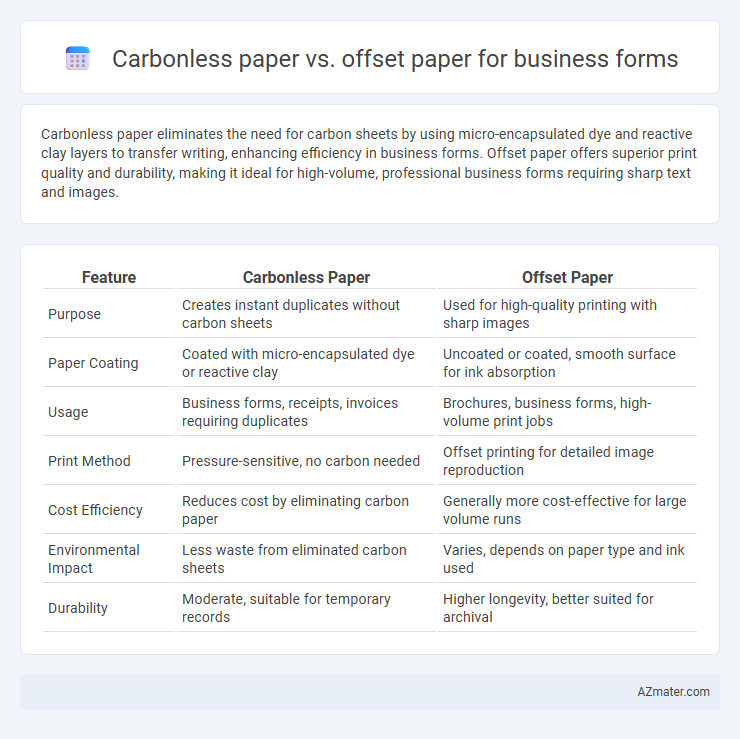Carbonless paper eliminates the need for carbon sheets by using micro-encapsulated dye and reactive clay layers to transfer writing, enhancing efficiency in business forms. Offset paper offers superior print quality and durability, making it ideal for high-volume, professional business forms requiring sharp text and images.
Table of Comparison
| Feature | Carbonless Paper | Offset Paper |
|---|---|---|
| Purpose | Creates instant duplicates without carbon sheets | Used for high-quality printing with sharp images |
| Paper Coating | Coated with micro-encapsulated dye or reactive clay | Uncoated or coated, smooth surface for ink absorption |
| Usage | Business forms, receipts, invoices requiring duplicates | Brochures, business forms, high-volume print jobs |
| Print Method | Pressure-sensitive, no carbon needed | Offset printing for detailed image reproduction |
| Cost Efficiency | Reduces cost by eliminating carbon paper | Generally more cost-effective for large volume runs |
| Environmental Impact | Less waste from eliminated carbon sheets | Varies, depends on paper type and ink used |
| Durability | Moderate, suitable for temporary records | Higher longevity, better suited for archival |
Introduction to Business Forms Paper Types
Carbonless paper and offset paper are essential materials in the production of business forms, each serving distinct purposes. Carbonless paper creates instant duplicates without carbon sheets, ideal for multi-part forms such as invoices and receipts, enhancing efficiency and reducing mess. Offset paper, known for its smooth surface and high print quality, is commonly used for single-sheet business forms requiring precise text and graphics, supporting professional presentation and durability.
What is Carbonless Paper?
Carbonless paper is a specialized type of paper designed to transfer information written on the top sheet to subsequent sheets without using carbon paper, commonly used in business forms for creating instant duplicates. It contains micro-encapsulated dye or ink on the back of the top sheet and reactive clay on the front of the sheet beneath, which react upon pressure to form a copy. This paper streamlines administrative processes by eliminating the need for messy carbon sheets, enhancing efficiency and legibility in multi-part business documents.
What is Offset Paper?
Offset paper is a high-quality, smooth-textured paper commonly used in commercial printing, particularly for business forms requiring sharp, clear text and graphics. It offers excellent ink absorption and durability, making it ideal for detailed documents and multi-page forms where professional presentation is essential. Unlike carbonless paper, which creates duplicates without carbon sheets, offset paper requires separate carbon sheets for making copies, providing flexibility in printing and finishing options.
Key Differences Between Carbonless and Offset Paper
Carbonless paper uses micro-encapsulated dye or ink that reacts upon pressure to create copies without carbon sheets, making it ideal for multi-part business forms. Offset paper, commonly used for high-quality printing, requires separate printing for each copy and relies on ink transfer from a plate to paper, resulting in sharper images and vibrant colors. The key difference lies in carbonless paper enabling instant duplicate creation through pressure sensitivity, while offset paper offers superior print clarity but needs separate processes for each form.
Printing Compatibility and Printer Requirements
Carbonless paper requires specific printing processes compatible with impact printers or specialized equipment to activate its micro-encapsulated coating, making it ideal for multi-part business forms. Offset paper suits traditional offset printing methods and laser or inkjet printers without special coatings, providing smooth, high-quality prints but lacking multi-layer duplication capabilities. Businesses must select carbonless paper for forms needing instant duplicates, while offset paper fits high-resolution, single-layer printing demands.
Durability and Practical Applications
Carbonless paper offers enhanced durability for business forms by preventing smudging and ensuring clear, legible copies without the need for carbon sheets, making it ideal for multi-part forms that require permanent records. Offset paper, known for its smooth surface and strength, provides a sturdy option for high-volume printing where durability and print quality are essential, especially in official documents and invoices. Practical applications of carbonless paper include receipts, invoices, and order forms requiring instant duplicated copies, while offset paper suits business forms needing heavy ink absorption and long-lasting physical integrity.
Cost Comparison: Carbonless vs Offset Paper
Carbonless paper often incurs higher initial costs due to its micro-encapsulated dye and clay coating technology that enables instant duplicate copies without carbon sheets. Offset paper generally has lower production costs, making it more budget-friendly for businesses requiring large volumes of forms where duplication is not needed. Evaluating the total expense involves factoring in the need for copies, printing methods, and volume, with carbonless paper being cost-effective for multi-part forms, while offset paper suits single-copy applications.
Environmental Impact and Sustainability
Carbonless paper, made with cellulose fibers and chemical coatings, generates less waste as it eliminates the need for carbon sheets, reducing paper consumption and harmful chemicals used in traditional processes. Offset paper typically involves higher resource use and carbon emissions due to the ink and energy-intensive printing methods, which may lead to greater environmental impact. Choosing carbonless paper for business forms supports sustainability by minimizing chemical residues, lowering energy use, and facilitating easier recycling compared to offset paper.
Choosing the Right Paper for Your Business Forms
Selecting the right paper for business forms depends on the purpose and printing method; carbonless paper offers self-copying capabilities ideal for multi-part forms, reducing the need for carbon sheets. Offset paper provides a smooth surface suitable for high-quality printing and is more cost-effective for single-copy forms without copy requirements. Evaluating factors like form duplication, print quality, and production volume ensures optimal paper choice for efficient business operations.
Conclusion: Which Paper Suits Your Business Needs?
Carbonless paper is ideal for businesses requiring instant multi-part forms without the need for carbon sheets, offering convenience and efficiency in transaction records. Offset paper provides superior print quality and durability, making it suitable for businesses prioritizing high-resolution graphics and long-lasting documents. Choose carbonless paper for cost-effective, handwritten duplicate forms, while offset paper is best for professional, visually appealing business forms with complex designs.

Infographic: Carbonless paper vs Offset paper for Business form
 azmater.com
azmater.com